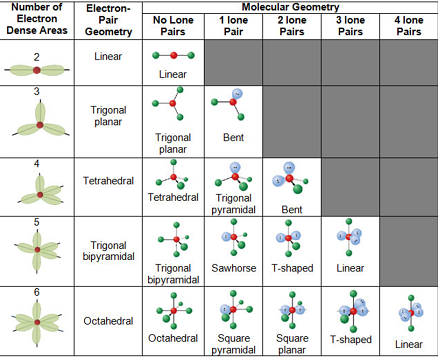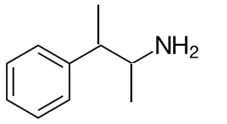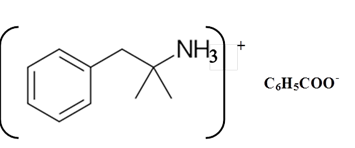
(a)
Interpretation:
The given amine needs to be labeled as 10, 20 or 30.
Concept introduction:
Answer to Problem 18.82P
A tertiary (3o) amine.
Explanation of Solution
Amines are derivatives which are derived from ammonia, wherein one or more hydrogen atoms have been replaced by a substituent such as an alkyl or aryl group. They can be called as alkylamines and arylamines.
Whether an amine is primary (1o), secondary (2o) or tertiary (3o) depends on the number of hydrogen atoms replaced by an alkyl or aryl group in ammonia. The amine is a primary amine if one hydrogen atom is replaced, it is a secondary amine if 2 hydrogen atoms are replaced and if three hydrogen atoms are replaced it is known as a tertiary amine.
The given compound is as follows:

Here, only one hydrogen atom is replaced and therefore this amine called as a primary (1o) amine.
(b)
Interpretation:
The molecular shape around each atom of phentermine needs to be determined.
Concept introduction:
Molecular geometry is named as molecular shape and it is the three-dimensional arrangement of atoms within a molecule of the environment. Atoms arrange in space with an exact shape to minimize the repulsion. This can be determined using VSEPR theory.
Answer to Problem 18.82P
Carbons of benzene molecule;trigonal planar.
Carbon of −CH2 / -C(CH3)2NH2 CH2-/-CH3;tetrahedral.
Nitrogen of NH2;trigonal pyramidal.
Explanation of Solution
VSEPR or Valence Shell Electron Pair Repulsion theory is a model used to determine the geometry of molecules considering minimum electrostatic repulsion between the valence electrons of central atom in the molecule.


Carbons of benzene molecule;
Number of bonds= 3
Number of lone pairs = 0
Therefore, the shape is trigonal planar.
Carbon of −CH2/ -C(CH3)2NH2CH2-/-CH3;
Number of bonds= 4
Number of lone pairs = 0
Therefore, the shape is tetrahedral.
Nitrogen of NH2;
Number of bonds= 3
Number of lone pairs = 1
Therefore, the shape is trigonal pyramidal.
(c)
Interpretation:
The constitutional isomer containing a primary amine needs to be determined.
Concept introduction:
Constitutional isomers are called as compounds that have the unique molecular formula and different structural connectivity. To determine whether two molecules are constitutional isomer, the number of each atom needs to be counted in both molecules and see how the atoms are arranged.
Answer to Problem 18.82P

Explanation of Solution
Whether an amine is primary (1o), secondary (2o) or tertiary (3o) depends on the number of hydrogen atoms replaced by an alkyl or aryl group in ammonia. The amine is a primary amine if one hydrogen atom is replaced, it is a secondary amine if 2 hydrogen atoms are replaced and if three hydrogen atoms are replaced it is known as a tertiary amine.

Here all one hydrogen atom is replaced and therefore this amine called a primary amine (1o).
(d)
Interpretation:
The constitutional isomer that contains a secondary amine needs to be determined.
Concept introduction:
Constitutional isomers are called as compounds that have the unique molecular formula and different structural connectivity. To determine whether two molecules are constitutional isomer, the number of each atom needs to be counted in both molecules and see how the atoms are arranged.
Answer to Problem 18.82P

Explanation of Solution
Whether an amine is primary (1o), secondary (2o) or tertiary (3o) depends on the number of hydrogen atoms replaced by an alkyl or aryl group in ammonia. The amine is a primary amine if one hydrogen atom is replaced, it is a secondary amine if 2 hydrogen atoms are replaced and if three hydrogen atoms are replaced it is known as a tertiary amine.

Here all 3 hydrogen atoms are replaced and therefore this amine called as a secondary amine (2o).
(e)
Interpretation:
The structure of phentermine hydrobromide molecule needs to be drawn.
Concept introduction:
Phentermine hydrobromide can stimulate the central nervous system and increases the blood pressure and heart rate which decreases the appetite. It is taken along with diet and exercise in order to reduce obesity.
Answer to Problem 18.82P

Explanation of Solution
Phentermine hydrobromide can stimulate the central nervous system and increases the blood pressure and heart rate which decreases the appetite. It is taken along with the diet and exercise in order to reduce the obesity.
Its molecular formula is C17H22BrN. It has the following structure.

(f)
Interpretation:
The products formed if phentermine is treated with benzoic acid needs to be determined.
Concept introduction:
Amines are derivatives which are derived from ammonia, wherein one or more hydrogen atoms have been replaced by a substituent such as an alkyl or aryl group. They can be called as alkylamines and arylamines.
Answer to Problem 18.82P

Explanation of Solution
Amines are derivatives which are derived from ammonia, wherein one or more hydrogen atoms have been replaced by a substituent such as an alkyl or aryl group. They can be called as alkylamines and arylamines.
Whether an amine is primary (1o), secondary (2o) or tertiary (3o) depends on the number of hydrogen atoms replaced by an alkyl or aryl group in ammonia. The amine is a primary amine if one hydrogen atom is replaced, it is a secondary amine if 2 hydrogen atoms are replaced and if three hydrogen atoms are replaced it is known as a tertiary amine.
Benzphetamine is a tertiary ammine. It has basic properties and it accepts protons from acids. Acetic acid is donated a proton to this amine and formed below the salt.

Want to see more full solutions like this?
Chapter 18 Solutions
General, Organic, & Biological Chemistry
- 19) Which metal is most commonly used in galvanization to protect steel structures from oxidation? Lead a. b. Tin C. Nickel d. Zinc 20) The following molecule is an example of a: R₁ R2- -N-R3 a. Secondary amine b. Secondary amide c. Tertiary amine d. Tertiary amidearrow_forwardpls helparrow_forwardIndicate the product of the reaction OH OH CH3-CC- Ph + H2SO4 a 20°C | CH3 Pharrow_forward
- 35) Complete the following equation by drawing the line the structure of the products that are formed. Please note that in some cases more than one product is possible. You must draw all possible products to recive full marks! a. ethanol + 2-propanol + H2SO4 → b. OH conc. H2SO4 CH2 H3C CH + K2Cr2O7 C. d. H3C A pressure CH3 + H2 CH Pt catalystarrow_forward21) The rate of reaction depends upon: a. the concentration and nature of reactants b. the temperature of the reaction C. whether or not a catalyst was used d. all of the above 22) A Maxwell-Boltzmann curve shows the distribution of molecular energies in a reaction system. When the temperature in this system is increased, the peak is a. higher and further to the right. b. higher and further to the left. c. lower and further to the right. d. lower and further to the left. 23) Which of the following correctly describes the reaction represented by the reaction below? CaCO3 (s) + energy → CaO (s) + CO2 (g) a. It is exothermic and the potential energy is greater in the reactants than the products. b. c. It is exothermic and the potential energy is greater in the products than the reactants. It is endothermic and the potential energy is greater in the products than the reactants. d. It is endothermic and the potential energy is equal for the products and reactants.arrow_forwardpls helparrow_forward
- 27) Draw the energy level diagram and write the full and shorthand electron configuration for a neutral sulfur atom.arrow_forwardIndicate whether these compounds are isomers, enantiomers, or tautomers. OCH OCH محمد ممدarrow_forward30) Substance A to E below are listed with several of their properties. The identities of the substances are identified in random order below: Iron, ethane, ethanol, sodium nitrate, graphite First classify each substance as either a polar covalent compound, non-polar covalent compound, ionic compound, metallic solid, or network solid. Write your predictions in the sixth coloumn of the chart, under "type of substance." Then, identify the identity of the substance in the last coloumn. Substance Melting Point Boiling Point Solubility in H₂O Electrical Conductivity Type of Substance Identity of Substance (°C) (°C) as: Solid, Liquids, Solution A -182 -88 Insoluble No/No/- B 1538 2862 Insoluble Yes/Yes/- C 308 380 Soluble Yes/Yes/Yes Ꭰ 3456 Insoluble No/-/- E -114 78 Soluble No/No/Noarrow_forward
 Organic Chemistry: A Guided InquiryChemistryISBN:9780618974122Author:Andrei StraumanisPublisher:Cengage Learning
Organic Chemistry: A Guided InquiryChemistryISBN:9780618974122Author:Andrei StraumanisPublisher:Cengage Learning Chemistry for Today: General, Organic, and Bioche...ChemistryISBN:9781305960060Author:Spencer L. Seager, Michael R. Slabaugh, Maren S. HansenPublisher:Cengage Learning
Chemistry for Today: General, Organic, and Bioche...ChemistryISBN:9781305960060Author:Spencer L. Seager, Michael R. Slabaugh, Maren S. HansenPublisher:Cengage Learning

